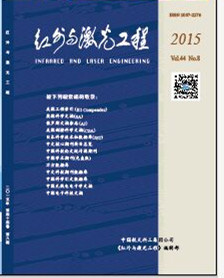Liu Jiaxiang, Fang Yonghua, Cui Fangxiao, Wu Jun. Surface contaminants detection method using brightness temperature spectroscopy[J]. Infrared and Laser Engineering, 2015, 44(11): 3469-3474.
| Citation:
|
Liu Jiaxiang, Fang Yonghua, Cui Fangxiao, Wu Jun. Surface contaminants detection method using brightness temperature spectroscopy[J]. Infrared and Laser Engineering, 2015, 44(11): 3469-3474.
|
Surface contaminants detection method using brightness temperature spectroscopy
- 1.
University of Chinese Academy of Sciences,Beijing 100049,China;
- 2.
Anhui Institute of Optics and Fine Mechanics,Chinese Academy of Sciences,Hefei 230031,China
- Received Date: 2015-03-17
- Rev Recd Date:
2015-04-19
- Publish Date:
2015-11-25
-
Abstract
To solve the shortcomings of surface contamination detection, a new method based on brightness temperature spectroscopy was presented. Firstly, an infrared remote sensing spectrometer with high sensitivity was employed to acquire contamination's spectrum in non-contact way. Taking advantage of the infrared source and the background having the same highly emission characteristics as blackbody, contaminants spectral features in brightness temperature spectra directly could be extracted by applying Planck's law. As this method does not require a previous measured background spectrum, it is very appropriate to be applied to poisoned accident sites. The principles of this method were discussed. Then this method and background subtraction method were employed to detect polydimethylsiloxane(PDMS), triethyl phosphate(TEP) on aluminum plate. The experiment results show that, the spectral features of contaminants extracted by brightness temperature spectroscopy are same as those acquired by background subtraction. It means that brightness temperature spectral features can be used to identify contaminants directly. Because there is no need to take background spectra before identification, this method could respond to chemical threats immediately and reliably, which make it a great application potential in surface contamination detection.
-
References
|
[1]
|
Li Gang, Wang Nanlin. An introduction to the principle and measurement technique of infrared spectroscopy[J]. Physics,2006, 35(10): 873-878. (in Chinese) 李岗, 王楠林. 红外反射光谱的原理和方法[J]. 物理, 2006, 35(10): 873-878. |
|
[2]
|
Fang Rongchuan. Solid State Spectroscopy[M]. Hefei: China University of Science an Technology of China Publishing Housing, 2001. (in Chinese) 方容川. 固体光谱学[M]. 合肥: 中国科学技术大学出版社, 2001. |
|
[3]
|
Wu Jinguang. Morden Fourier Transform Spectrocopy and Its Applications[M]. Beijing: China Science and Technology Literature Publishing House, 1994. (in Chinese) 吴瑾光. 近代傅里叶变换红外光谱技术及应用[M]. 北京: 科学技术文献出版社, 1994. |
|
[4]
|
Smith D Y, Shiles E, Mitio Inokuti, et al. Handbook of Optical Constants of Solids[M]. San Diego: Academic Press Limited, 1985. |
|
[5]
|
Diken Eric G, Josep Arno, Ed Skvorc, et al. Advances in field-portable ion trap GC/MS instrumentation[C]//SPIE, 2012, 8358(8358H): 1-17. |
|
[6]
|
Ren Braun, Jens Eichmann, Samer Sabbah, et al. Remote detection of liquid surface contamination by imaging infrared spectroscopy: measurements and modelling[C]//SPIE, 2008, 7116(7116S): 1-12. |
|
[7]
|
Roland Harig, Ren Braun, Chris Dyer, et al. Short-range remote detection of liquid surface contamination by active imaging Fourier transform spectrometry[J]. Optics Express, 2008, 16(8): 5708-5714. |
|
[8]
|
Andreas Beil, Rainer Daum, Roland Harig, et al. Remote sensing of atmospheric pollution by passive FTIR spectrometry[C]//International Society for Optics and Photonics, 1998: 32-43. |
|
[9]
|
Dengke Cai, Andreas Neyer, Rdiger Kuckuk, el al. Raman, mid-infrared, near-infrared and ultraviolet-visible spectroscopy of PDMS silicone rubber for characterization of polymer optical waveguide materials[J]. Journal of Molecular Structure, 2010, 976(2010): 274-281. |
|
[10]
|
Annia H Kycia, Mansoor Vezvaie, Vlad Zamlynny, et al. Non-contact detection of chemical warfare simulant triethyl phosphate using PM-IRRAS[J]. Analytica Chimica Acta, 2012, 737: 45-54. |
-
-
Proportional views

-









 DownLoad:
DownLoad: